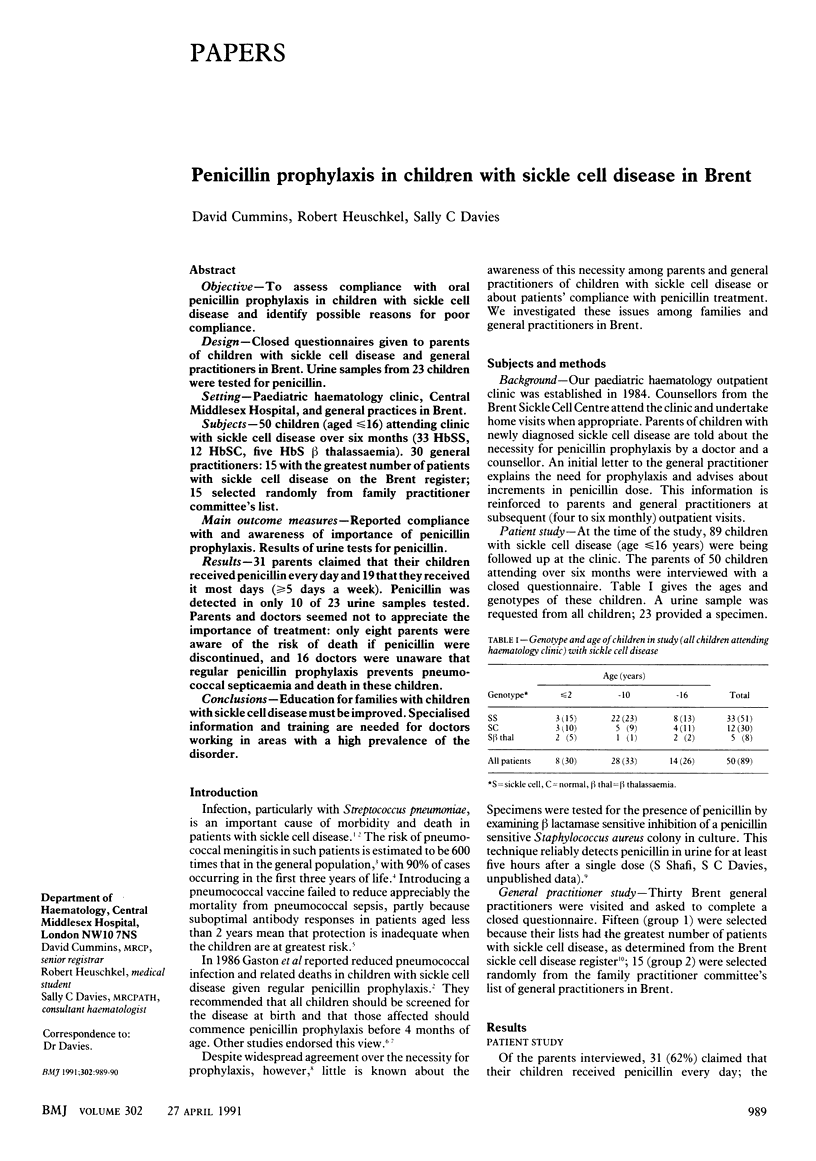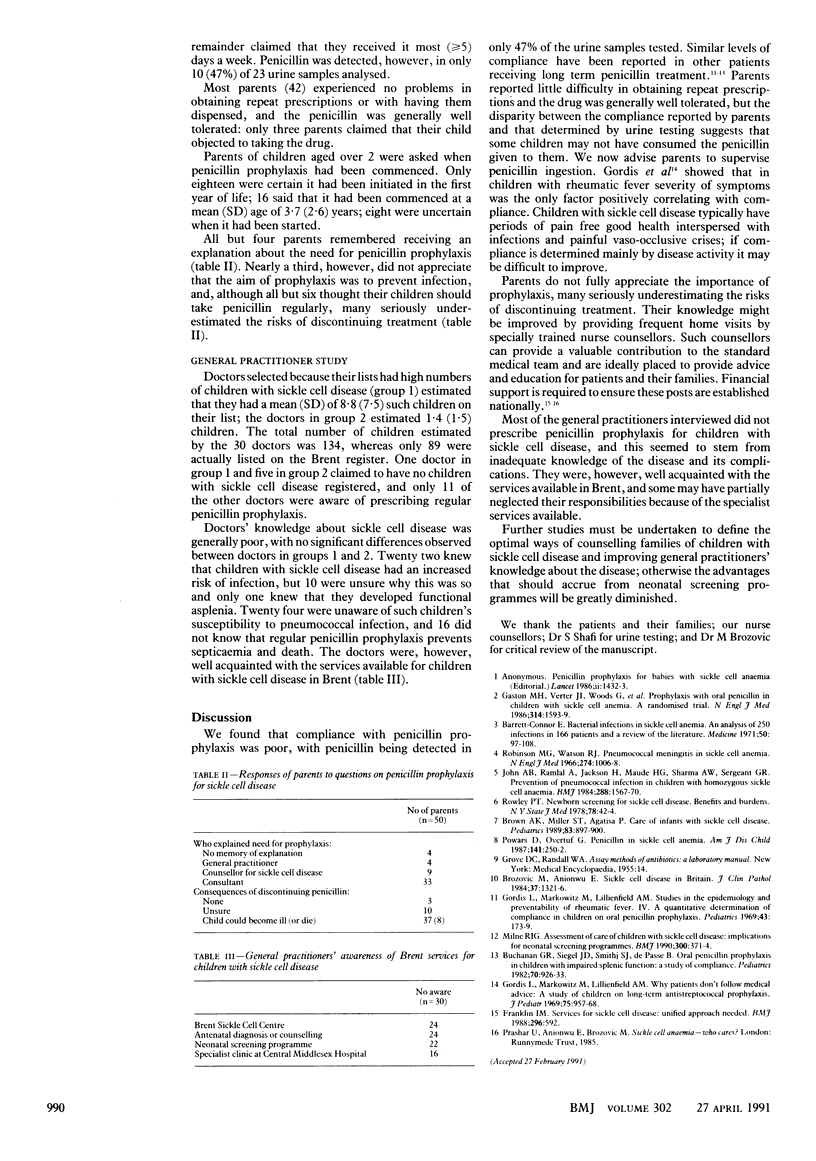Abstract
OBJECTIVE--To assess compliance with oral penicillin prophylaxis in children with sickle cell disease and identify possible reasons for poor compliance. DESIGN--Closed questionnaires given to parents of children with sickle cell disease and general practitioners in Brent. Urine samples from 23 children were tested for penicillin. SETTING--Paediatric haematology clinic, Central Middlesex Hospital, and general practices in Brent. SUBJECTS--50 children (aged less than or equal to 16) attending clinic with sickle cell disease over six months (33 HbSS, 12 HbSC, five HbS beta thalassaemia). 30 general practitioners: 15 with the greatest number of patients with sickle cell disease on the Brent register; 15 selected randomly from family practitioner committee's list. MAIN OUTCOME MEASURES--Reported compliance with and awareness of importance of penicillin prophylaxis. Results of urine tests for penicillin. RESULTS--31 parents claimed that their children received penicillin every day and 19 that they received it most days (greater than or equal to 5 days a week). Penicillin was detected in only 10 of 23 urine samples tested. Parents and doctors seemed not to appreciate the importance of treatment: only eight parents were aware of the risk of death if penicillin were discontinued, and 16 doctors were unaware that regular penicillin prophylaxis prevents pneumococcal septicaemia and death in these children. CONCLUSIONS--Education for families with children with sickle cell disease must be improved. Specialised information and training are needed for doctors working in areas with a high prevalence of the disorder.
Full text
PDF

Selected References
These references are in PubMed. This may not be the complete list of references from this article.
- Barrett-Connor E. Bacterial infection and sickle cell anemia. An analysis of 250 infections in 166 patients and a review of the literature. Medicine (Baltimore) 1971 Mar;50(2):97–112. [PubMed] [Google Scholar]
- Brown A. K., Miller S. T., Agatisa P. Care of infants with sickle cell disease. Pediatrics. 1989 May;83(5 Pt 2):897–900. [PubMed] [Google Scholar]
- Brozović M., Anionwu E. Sickle cell disease in Britain. J Clin Pathol. 1984 Dec;37(12):1321–1326. doi: 10.1136/jcp.37.12.1321. [DOI] [PMC free article] [PubMed] [Google Scholar]
- Buchanan G. R., Siegel J. D., Smith S. J., DePasse B. M. Oral penicillin prophylaxis in children with imparied splenic function: a study of compliance. Pediatrics. 1982 Dec;70(6):926–930. [PubMed] [Google Scholar]
- Gaston M. H., Verter J. I., Woods G., Pegelow C., Kelleher J., Presbury G., Zarkowsky H., Vichinsky E., Iyer R., Lobel J. S. Prophylaxis with oral penicillin in children with sickle cell anemia. A randomized trial. N Engl J Med. 1986 Jun 19;314(25):1593–1599. doi: 10.1056/NEJM198606193142501. [DOI] [PubMed] [Google Scholar]
- Gordis L., Markowitz M., Lilienfeld A. M. Studies in the epidemiology and preventability of rheumatic fever. IV. A quantitative determination of compliance in children on oral penicillin prophylaxis. Pediatrics. 1969 Feb;43(2):173–182. [PubMed] [Google Scholar]
- Gordis L., Markowitz M., Lilienfeld A. M. Why patients don't follow medical advice: a study of children on long-term antistreptococcal prophylaxis. J Pediatr. 1969 Dec;75(6):957–968. doi: 10.1016/s0022-3476(69)80332-x. [DOI] [PubMed] [Google Scholar]
- John A. B., Ramlal A., Jackson H., Maude G. H., Sharma A. W., Serjeant G. R. Prevention of pneumococcal infection in children with homozygous sickle cell disease. Br Med J (Clin Res Ed) 1984 May 26;288(6430):1567–1570. doi: 10.1136/bmj.288.6430.1567. [DOI] [PMC free article] [PubMed] [Google Scholar]
- Powars D., Overturf G. Penicillin in sickle cell anemia. A panacea for the lost spleen? Am J Dis Child. 1987 Mar;141(3):250–252. doi: 10.1001/archpedi.1987.04460030028017. [DOI] [PubMed] [Google Scholar]
- Robinson M. G., Watson R. J. Pneumococcal meningitis in sickle-cell anemia. N Engl J Med. 1966 May 5;274(18):1006–1008. doi: 10.1056/NEJM196605052741806. [DOI] [PubMed] [Google Scholar]
- Rowley P. T. Newborn screening for sicle-cell disease. Benefits and burdens. N Y State J Med. 1978 Jan;78(1):42–44. [PubMed] [Google Scholar]


